National Historic Trails Interpretive
Center
July 8 2006:
Let me situate you concerning
where we are and what we are doing. Earlier on this trip we had visited Scott's
Bluff, Nebraska a prominent place on the Overland Trail. From Scott's Bluff we
followed the North Platt
River west on US-26 into eastern Wyoming. We made stops at several historic
places as we made our way to Casper, Wyoming where we stopped for the night. We
stopped at Fort Laramie,
then again at the Register Cliffs
State Historic Site near Guernsey, Wyoming which is where we are now.
Then we continued a few miles down US-26 to the Oregon
Trail Ruts State Historic Site which is also in Guernesy. From The Oregon
Trail Ruts State Historic Site we continued our journey to Casper, Wyoming
before stopping for the night.
We have arrived in Casper, Wyoming and are
going to visit the National Historic Trails Interpretive Center today.
Joyce
and I spent the night in Casper East RV-Park Casper, Wyoming. Casper East
RV-Park is a mom and pop operation without a mom & pop! N42° 51.357' W106°
17.338' $24 for water & 30-amps central sewage. They feature gravel interior
roads & pads: This is NOT a campground we would relish staying in again. We
will look for a PPA Campground the
next time we are in Casper or we will stay at the Fort Casper RV-Park.

The National Historic Trails
Interpretive Center in Casper, Wyoming
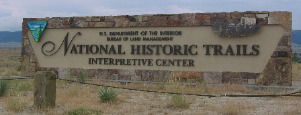
The
National Historic Trails Interpretive Center in Casper, Wyoming tries to chronicle
all of the trails and migrations west during the 1800's.
For emigrants who
reached this portion of the Oregon, California, Mormon Pioneer, Pony Express trails
between 1846 & 1868, the landscape was changing daily and new challenges lay
ahead.
The importance of the Oregon, Mormon Pioneer, California and
Pony Express Trail dwindled for emigrants with completion of the transcontinental
railroad in 1869. However, the trail was still utilized by a few travelers and
the military, especially after Fort
Laramie became a hub of activity during the Indian Wars period.
It is estimated that 500,000 people ventured westward over the trails to settle
and develop the vast resources of the American West. Soon, however these trails
began to wain in importance. With the completion of the transcontinental railroad
in 1869 the 2,000 mile journey that once took up to 6-months by wagon or on foot
could be accomplished by rail in a mere two weeks.
The road west can be
described in a number of ways: Settlement of new lands (Oregon & California),
freedom from religious persecution (Mormon migration to Utah), quest for personal
riches (California Gold Rush), communications (Pony Express) and commerce were
all reasons for this road west.
Although overlaps occur 5-general trail
eras can be identified:
The Mountain Men discovered the trail and used
it prior to the 1840's.
Then came the Oregon Trail era: The Bidwell-Bartleson
wagon train left Independence Missouri in the spring of 1841, bound for the fertile
valleys of Oregon and Washington. They pioneered the westward migration. Their
2,400 mile journey ended in Oregon near the Columbia River Valley/Oregon City
area.
Next came the California Trail era: This trail started shortly
after the first wagon train left for Oregon but achieved prominence in 1848 when
gold was discovered at Sutter's Mill in California. In 1849 alone approximately
30,000 "Forty-Niners" used it to reach the gold fields. Many more emigrants
followed in subsequent years.
Then came the Mormon Pioneer era: Seeking
freedom to practice their religious beliefs, Brigham Young led the followers of
Mormonism from the banks of the Mississippi River into what is today Utah. In
1846 they left Nauvoo, Illinois and wintered along the Missouri near present day
Omaha, Nebraska. In the spring of 1847 they departed for the Great Salt Lake of
Utah. By late July, the pioneers had completed their 1,400 mile trek. Inspired
by this first group of 148 emigrants, nearly 70,000 followed the trail over the
next 20-years, most seeking sanctuary in the Great Salt Lake Valley.
Finally the Pony Express days: With emigrants now settled on the west coast the
need for communications became necessary. The Pony Express Trail was the first
inland communications route linking the Eastern United States with new settlements
in the west. Beginning in April of 1860 riders began carrying mail from St Joseph,
Missouri to San Francisco, California. With a series of stations along the way
to supply fresh horses and riders, the 2,000 mile trip could be completed in only
10-days. Although service was terminated in November of 1861-coinciding with completion
of the transcontinental telegraph line-the Pony Express provided a vital communications
link between the east and west.
Life along "The-Trail" was constantly changing.
In the early years there was just a trickle of Mountain Men and traders then emigrants
to Oregon began to increase. Those early travelers may have never laid eyes on
another "white person", other than their party, on the entire journey.
However, as the years past there was a constant flow of people and wagons west.
In the heavy flow years, beginning in 1849 with the California gold-rush, it was
common for groups to meet other groups many times over the course of their journey.
One group may lay over a day for rest or good pasture for the livestock and be
passed by many other groups only to catch up and pass those groups when they had
a rest day.
The era of the Forty-Niners saw groups of men heading to
the California gold fields with no wagons to encumber them. They moved fast taking
only the minimum supplies. Some walked the entire way with only a pack animal
to carry supplies.
As western settlements became populated suppliers
and supply wagons began making the trip. These supply trains not only supplied
trading posts along the route some even made the complete trip to the west coast.
Supply wagons were BIG in comparison to the much smaller wagons emigrants used.
Ten yoke of oxen (20-oxen) were hitched to one wagon that had another wagon attached
to the back of it. Sometimes these supply wagons were pulled by teams of mules.
Which ever beast of burden was used you can be sure there was much work for the
men tending to them.
Many individuals and groups stand out in making
this epic journey possible for those that followed.
Army Officer John
Freemont with his, scout Kit Carson and his map maker Charles Preuss's surely
are near the top of any such list. In 1842 Lieutenant John Freemont let an expedition
west to map a route to the Oregon Territory. Freemont's report and Charles Preuss's
maps were published and widely distributed. They were heavily used by emigrants.
The Mormon's also did much to enhance to arduous journey for those that followed.
Early Mormon parties gathered information and tested techniques to make the journey
easier for those who would follow. Difficult and unorganized travel from Nauvoo,
Illinois, to winter quarters near present day Omaha, Nebraska, taught church leaders
that both discipline and planning was necessary if a mass migration were to succeed.
Mormons shared their new found knowledge by leaving signs along the way, publishing
a guide, and sending supplies from Salt Lake City back to winter quarters to help
the next wave of emigrants. These out-and-back trains were unique to the Mormon
migration. They provided Oxen, wagons and experienced guides to new groups of
emigrants.
Knowing that information would be important to later emigrants,
Brigham Young selected William Clanton to record the journey of the Mormon's first
Pioneer Party. Clanton suggested the creation of a "roadometer" that
could be attached to a wagon wheel to measure distances. He also published the
most accurate guide of the trail that benefited later emigrants both Mormon and
non-Mormon alike.
Mike experiencing a "Mormon"
hand cart
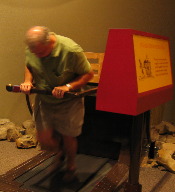
The
Mormon companies that make the trek to to the Great Salt Lake Valley really captured
my attention. Some of these companies made the trip with hand-carts. Usually two
or three men would join forces with one hand cart to carry all their earthly posessions.
One or two would pull the cart while the other pushed. Food supplies and bedding
would be transported by Mormon wagons drawn by oxen. By using this method many
more emigrants were able to make the journey.
While visiting the National
Historic Trails Interpretive Center in Casper, Wyoming I had a chance to experience
pulling a Mormon hand cart like the ones they used to pull/push their earthly
possessions across the mid-west. This was a diorama where you could get on a tredmill
and experience pulling one of those Mormon handcarts. A display told you how fast
you were pulling the cart in relation to how fast you would have to go to make
the required 15-miles per-day. I can guarantee you that there were no "fat-boys"
on that trip.
Sampling of name & date
on register cliffs along the journey
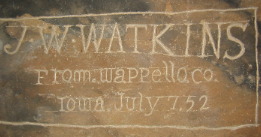
Another
display at the National Historic Trails Interpretive Center was their "register"
wall where a sampling of names & dates on register cliffs throughout Wyoming
have been duplicated. When I say duplicated I mean down to the color of the rock
the name & date is inscribed on.
Sampling
of name & date on register cliffs
along the journey
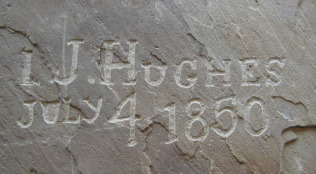
It is interesting to see these names and dates on this wall without having to
search through so many graffitti artist names that have been added since the days
of the great migration.
Mormons and others built and operated ferries and
bridges across the North Platte River that most assuredly helped make the trip
possible for wagons.
In the summer of 1847 ten Mormons stayed throughout
the summer to run a ferry across the North Platte River and operate a blacksmith
shop near present day Casper, Wyoming. Their operation was a tremendous help for
both Mormon and non-Mormon alike.
The Mormons operated another ferry
at another treacherous crossing on the Green River beyond South Pass.
Things along the trail drastically changed in 1949 when over
30,000 forty-niners flooded over the trail. Businesses sprang up ending the "wilderness-experience"
that earlier emigrants had experienced. In the 1850's emigrants could stop at
improvised supply points and blacksmith shops along the way. They could have their
wagons repaired and oxen re-shod while buying supplies and food. They could also
trade out worn out animals for fresh stock. Some merchants even collected and
resold items that had been discarded by emigrants that had overpacked.
In
1852 John Baptise Richard (pronounced REE-shaw) built a toll bridge over the North
Platte River near present day Casper, Wyoming. It was the primary bridge for the
migration from 1852 until 1860. While emigrants could ford at no cost most paid
up to $5.00 per-wagon to cross the bridge. Cost per-wagon was determined by how
much water was flowing in the river. The higher the river the more it cost to
use the bridge.
Richard's Toll Bridge across the
North Platte River near
Casper, Wyoming
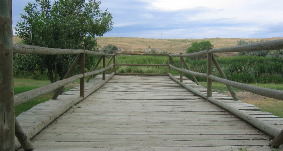
One
Oregon emigrant, John Murray, wrote on June 9, 1853: "The bridge is a substantial
structure-it has 8 wood framed piers filled and sunk with rock and the reaches
are supported by heavy braces. The sides are railed up and the bottom planked.
The bridge is about 150-yards long and comes out on the north side on a rocky
bank...at each end of the bridge are Indian lodges and trading houses and a blacksmiths
shop. Above the bridge about a mile is another trading post where they have lots
of horses and mules for sale or trade."

This has been an awsome stop for us. I don't know
how it could have been any better.
Until next time remember how good life
is.
Mike
& Joyce Hendrix
Until next time remember how good
life is.
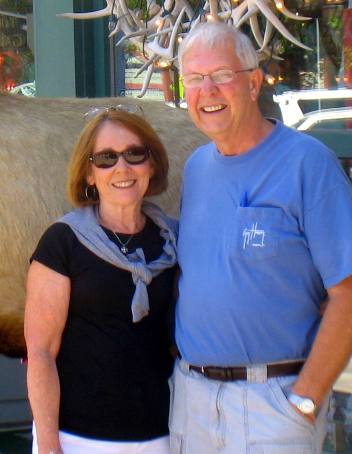
Mike
& Joyce Hendrix who we are
We
hope you liked this page. If you do you might be interested in some of our other
Travel Adventures:
Mike & Joyce Hendrix's
home page
Travel
Adventures by Year ** Travel
Adventures by State ** Plants **
Marine-Boats ** Geology
** Exciting Drives ** Cute
Signs ** RV
Subjects ** Miscellaneous
Subjects
We
would love to hear from you......just put "info" in the place of "FAKE"
in this address: FAKE@travellogs.us
Until next time remember how good life
is.





